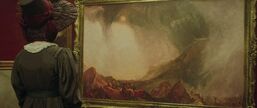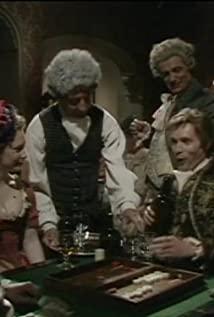The British have always been fond of their national treasures and historical celebrities. This year marks the 240th anniversary of the birth of the painter JMW Turner. Since September last year, the Tate Gallery in the UK has been on display for nearly a period of time. Half-yearly Turner exhibition. The film "Mr. Turner" must have just happened to be filmed through such an opportunity. Since its release, it has been well received and won the Best Actor Award at the 67th Cannes Film Festival and was nominated for the Palme d'Or for Best Picture.
For people who know a little bit about art, Turner is definitely a name that catches the eye. He is a great romantic landscape painter, the pioneer of the British naturalism, the "distant ancestor" of the Impressionist school, and the enlightenment and important influencer of the later impressionist master Monet, known as "the painter of light", "landscape painting" Shakespeare in ". At the age of 21, he published his first representative work, Fisherman at Sea, which shocked the painting world. At the age of 26, he was exceptionally promoted to the youngest member of the Royal Academy of Arts, and became an outstanding member three years later. He soon became an important leader and leader in the British painting circle at that time. Many of his prolific and progressive works were highly praised and appreciated in the era of his life, and loved by the upper class and the nobility who advocated the classical style. In the movie, we can see that there were private collectors who were willing to pay £100,000 to acquire Turner's famous paintings. Therefore, when Turner was alive, even if he had not reached the status of a generation of grandmasters, he was still successful. Compared with many of Van Gogh's life experiences who were destitute in life and whose paintings are of astonishing value after his death, Turner, who is sensitive and surly, is undoubtedly the lucky one of the times. Although he devoted himself to the exploration of painting form and color in his later years, especially since the 1840s, his over-fascination with and expression of light and shadow made the painting style more and more abstract, which attracted a lot of controversy, but he was still regarded as a British One of the greatest painters.
If we have seen the biographical films of art masters such as Caravaggio, Vermeer, Goya, Dali, Andy Warhol, etc., the psychological presupposition of this film should also be like this: the life of an artist is always a personality And special, even if there is no ups and downs of the legendary story, there will be a beautiful and romantic atmosphere. But this time it was clear that we were going to be disappointed. The story in the film begins when Turner is 51 years old. The almost old artist shows a chaotic temperament. He has no dashing demeanor. He is short and fat, coughing and shaking like a hulking monster. Occasionally there is light, but most of the time, it does not meet people's eyes, but dodges around; the lower lip is absolutely protruding, like a teapot mouth, and when it speaks, it grumbles. The way he paints at the painter is also unattractive, and those shocking works can be made with controversial methods such as ingredients and spit. With the clothes, hairstyle and gait, a brutish and weird Turner appeared in front of his eyes.
In addition to the creative career of running around and sketching, the rest of his personal life is almost simple and even lonely. The younger sister died young, and the mother went to a lunatic asylum until she died. Although he is young and successful, he has both fame and fortune, but he has a withdrawn personality. He has been with his father for nearly 30 years in the second half of his life, and he is still deeply dependent on his father in life and emotion at an age. Although he has two daughters, he is also indifferent. Disgusted and needed by the ugly and loyal maid, she vents her lust on her like a beast. During his class at the academy, he was nervous and boring, making the audience below him unbearable. After his father's death, he fell into depression step by step, left home to explore, rented a small house on the seaside of Margate, and eventually developed the widowed landlord into a mistress and became a new object of dependence for the rest of his life.
If it is just these trivial and boring life narratives, the film loses the value of discussion. The director's ambition is to package the poetic world of a great artist in a mediocre form. This poetry is cryptic, yet ubiquitous. The director said in an interview: "We read a lot of books about Mr. Turner. There are millions of such books on the market, but reading these books doesn't mean you can find the Turner in front of your camera." To do a good job in the restoration of historical figures, Mike Lee specially studied Turner's paintings of that year, and drew sketches for film shooting according to the relationship between the characters and backgrounds of the pictures, and strived to focus on light and tone, natural scenery, background architecture, clothing and makeup and other aspects. It is now the style of the Victorian period at the turn of the 18th and 19th centuries. There are not a lot of scenes directly painted by the artist in the film, but director Mike Lee deliberately simulates a considerable number of landscapes and compositions in Turner's paintings with his lens, which makes the whole film present a refined and elegant oil painting style, with an emphasis on light and style. The grasp is precise and vividly reproduces the charm of Turner's work. Turner advocates the use of natural light and color to express subjective emotions, and believes that the best carrier of emotion is the air and light in nature. We can also find similar artistic expressions under the lens of Mike Lee's delicate and almost works of art. The opening chapter is a sketch of a mill in the Dutch countryside, the beautiful dusk of the Lord's Manor, the beautiful seascape of Margate, when Turner stood in the studio painting and saw his father and maid Hannah working outdoors, boating with friends on the Thames River, etc., one frame Frames can be frozen and presented as independent works. The photographer used a digital lens to capture the drifting and delicate light movement and the contrast of tones, and vividly used Turner's own brushstrokes and painting style to reproduce his daily life and style. The source of creation, and from these subtle and sensitive lens images, accurately and delicately expresses the poetry that Turner saw in the eyes and experienced emotionally in the surrounding environment.
As the camera progresses, we gradually have an emotional tolerance and understanding of the protagonist with a poor external image. Under his rude, clumsy and indifferent and arrogant appearance, he hides a richness, delicacy, sensitivity and softness. 's heart. Many great artists are naive all their lives, and Turner also has this trait, so he loves his father and avoids family responsibilities. He rarely paints portraits because he is ashamed to look directly at people. He also has a vain side, craving attention and affirmation. Although he is over half a hundred years old, he has not been coerced by the world and matured at the same time. He can only use a surly shell to arm himself and find a place in the world. Only when he encounters beautiful things that touch his inner emotions will he reveal his true nature. In the Lord's Manor, he found tacit understanding and resonance with the piano teacher in the music, accompanied by the piano accompaniment, he sang emotionally. Although he sang clumsily, out of tune, and forgot his words, he was full of tenderness, enough to move the piano teacher. In the scene where he was sketching a prostitute, he cried like a child in front of a girl with youth and a beautiful body. Sympathy for a friend's embarrassment and debt forgiveness are also carried out in a rigid manner. Of course, there are countless times when facing nature and depicting those human sights, aside from all the worldly pretense, he has created a splendid poetic world by himself.
The protagonist, Turner, is played by British actor Timothy Spall, who has contributed a very good acting talent here, and has even been criticized as surpassing his 1996 Palme d'Or award-winning work with Mike Lee. Secrets and Lies. The director commented on him: "acting a person who has love but doesn't know how to express it".
There is such a bridge in the film, describing how Turner was inspired to create the representative work "The Fighting Temeraire" in 1839. The painter did not leave the main picture to the old, damaged battleship, but instead highlighted the light black boat that was towed and piloted in front. "That's the ghost of the past." Turner's friend said sadly to the ship. "No," cried Turner, "the past is over. We're looking to the future. Smoke, steel, steam." Light, by definition, is the fastest. Turner, who is good at capturing and describing light, was criticized more and more by people in the late period, just because he foresaw the future, and with the help of his talent and diligence, he got ahead of his time, leaving his contemporaries far behind. .
In the last shot of Turner, he said a sentence before his death: The sun is God.
View more about Mr. Turner reviews











